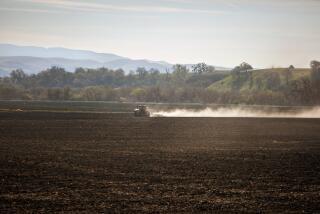Farmers Markets: Medjool date line moves east into Arizona
YUMA, Ariz.— On an arid mesa in the southwestern corner of Arizona, surrounded by scrubland, cotton and alfalfa fields, grow 2,700 acres of Medjool date palms, most of them young and just starting to bear. Few people know about this orchard yet, but it’s the largest planting of Medjools in the world, in a state where dates were a minor crop until just recently.
In time this will be part of a notable shift in where our dates are grown. Bard, Calif., across the Colorado River, is still the largest source for Medjools, but it will be eclipsed by Yuma, which has been better known for its lemons and winter vegetables. The Coachella Valley, southeast of Indio, is still the largest date growing district overall, including Deglet Noors and other varieties, but the greater Yuma area is likely to supplant it within seven years.
Prized for its large size, tender flesh and excellent flavor, Medjool is the primary date variety eaten fresh in the United States, but its preeminence emerged slowly. When domestic date cultivation started a century ago in the Coachella district, it focused on the Deglet Noor variety, and much of the crop was used in baking and processing.
Originating at the remote Bou Denib oasis in Saharan Morocco, Medjool palms were not successfully imported to the United States until 1927. Development of new orchards took decades, because the palms had to be propagated by offshoots, and most Coachella growers did not recognize the variety’s potential.
A century ago, agricultural pioneers realized that Arizona had the desert climate to be a major date producer, but this potential was not fulfilled until recently. The USDA started importing quantities of date offshoots from the Middle East to Arizona in 1900, and in the 1920s and 1930s a small industry developed in the Phoenix area. It peaked at about 450 acres in the 1940s, but most of the plantings were pulled out because of freezes, summer rains, and urbanization, and little remains today. Interest in growing dates in southwestern Arizona was almost nonexistent.
In 1933, growers started planting dates in Bard, across the Colorado River from Yuma, drawn by fertile alluvial soil and readily available water. Compared with Coachella, the area gets more late-summer monsoonal rains and humidity, which can spoil the crop, so varieties such as Deglet Noor did not do well in Bard.
Two early growers planted the first Medjool offshoots in the Bard Valley in 1944, and over time the variety proved well adapted to the area. Growers developed horticultural practices to perfect it, such as muslin bags to protect the crop from rain and rings to spread the date strands, to improve ventilation. Today Bard arguably produces the world’s best Medjools, with a plump appearance and smooth texture. It is the nation’s leading source, producing about 15 million pounds from 1,500 acres.
In the 1990s the area’s largest date grower, Gusmar Nunez of Imperial Date Gardens, looked to expand, but land in Bard was scarce and expensive because of competition from vegetable farmers, as he related over breakfast last Monday. But Nunez noted that a small Medjool orchard established in the 1980s thrived on the Yuma mesa, so he boldly started planting there, big time.
The area has both drawbacks and advantages for date culture, Nunez said. The porous soil is a challenge, requiring application of 200 gallons of water daily per palm, pumped from the local aquifer. The fertilization of young trees is less efficient, and so fruit size is initially smaller than in Bard. But Yuma has one advantage for quality: The skin is less likely to separate from the fruit and form papery bits that stick to the roof of the consumer’s mouth. Perhaps just as important for growers, taxes are lower and regulations less stringent in Arizona than in California.
Several growers across the border in Mexico, where labor costs are lower, have also planted dates and, including this district and Bard, there are about 6,500 acres in the greater Yuma area. In five or seven years, when the current plantings reach maturity, the area likely will surpass the Coachella Valley in total date production, including all varieties, said Dave Nelson, president of Bard Valley Medjool Date Growers, a cooperative that markets most of the crop under its Natural Delights brand.
The harvest started about two weeks early this year, in mid-August, and will run through September. The last month or so has been atypically humid in both the Coachella and Yuma districts, and some growers have reported damage to their crops, but overall both quantity and quality are high.
The most exquisite Medjools are those in the moist rutab stage, but these are so delicate and perishable that growers dry almost all the crop to the firmer, more durable tamar stage. Until a decade ago, Medjools were dried on trays in the sun, but because of food safety concerns, almost all are dehydrated indoors today.
Through October, Imperial sells rutab Medjools by mail order, $48 for 4 pounds, plus overnight shipping. At Southern California farmers markets, superb rutab and tamar Medjools from Coachella are available from DaVall Date Gardens (Pasadena Saturday, Irvine, Hollywood, Studio City and Santa Monica Wednesday), Flying Disc Ranch (Santa Monica Wednesday), Four Apostles Ranch (Santa Monica Saturday downtown), Bautista Family Organic Date Ranch (Torrance Saturday, Long Beach Marina, Beverly Hills, Hollywood, and Santa Monica downtown on Wednesday, at Virginia Park on Saturday and on Main Street on Sunday), Oasis Date Gardens (Mar Vista, Calabasas, Brentwood) and Pato’s Dream Date Gardens (Alhambra).
Tip of the week: Al Courchesne of Frog Hollow Farm will return to the Santa Monica farmers market on Wednesday with his supersweet and flavor-packed Warren pears, grown in Brentwood, east of San Francisco. A cross of Seckel and Comice, with the sweetness and spiciness of the tiny Seckel, and the larger size and lusciousness of Comice, Warren is virtually unobtainable from other farms, although Michael Cirone of San Luis Obispo has a few young trees and should have some fruit shortly at the Wednesday market. Farmshop, at the Brentwood Country Mart in Santa Monica, will also carry Frog Hollow Warren pears.
More to Read
Eat your way across L.A.
Get our weekly Tasting Notes newsletter for reviews, news and more.
You may occasionally receive promotional content from the Los Angeles Times.










